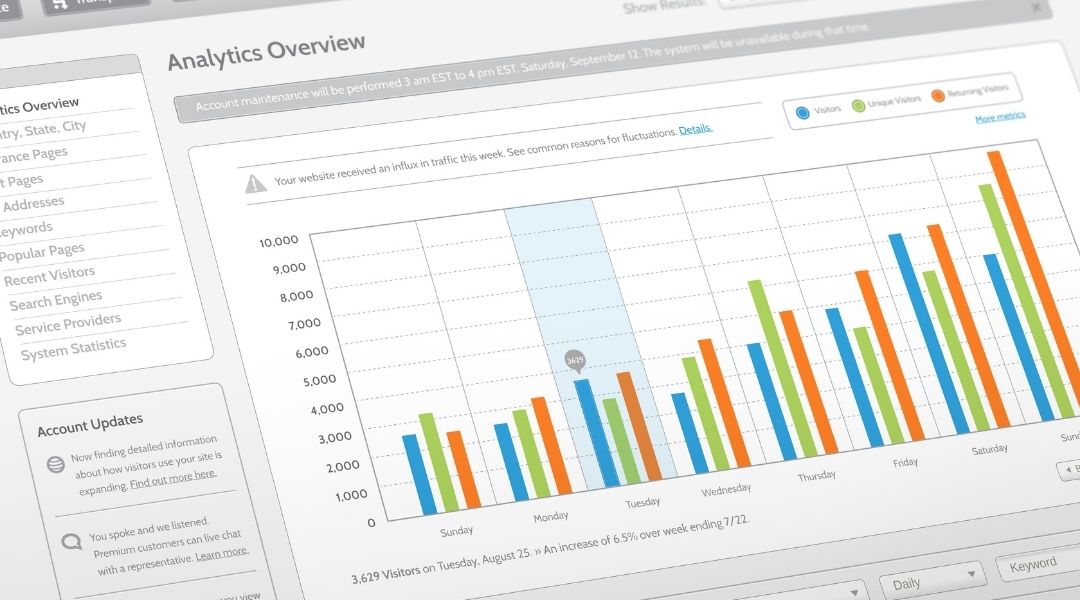Knowing how visitors behave on your site is the first step to winning the SEO game. Imagine filming their moves, then hitting pause to study what’s working and what’s not. Patterns in user behavior tell a story—one that reveals what captures users’ attention.
Improve your website’s user experience by tapping into UBA data—it’s a smart move that pays off. When search engines take notice, you can bet your bottom line will, too—conversions are sure to climb. Your SEO skills are about to get a major upgrade—here’s how to harness these expert insights to drive real traffic and conversions.
How people naturally respond to your page’s various sections can reveal a lot. Two critical performance indicators can reveal where your website’s falling short: the percentage of people clicking through and those who quickly bail out. For example, a low CTR could suggest that titles or meta descriptions aren’t catching enough attention in search results. Adapt your content to your visitors’ moves, and you’ll serve up exactly what they’re hunting for.
This leads not just to higher traffic but more meaningful interactions as well—exactly what search engines favor when determining rankings. We’ll show ways to boost both ranking positions and overall visit quality through smart application of user data, user behavior, and SEO.
What Is User Behavior Analytics in SEO?
User Behavior Analytics in SEO revolves around tracking and analyzing how users engage with a website. This approach uncovers what attracts or deters visitors, guiding the refinement of SEO tactics.
- Click patterns sample: Seeing which pages and links draw attention lets you pinpoint content that resonates with your audience. High click rates indicate areas of interest or successful calls to action. Conversely, low interaction points out where improvements are needed. Optimizing these elements can significantly enhance user experience and site performance.
- Engagement time sample: The amount of time spent on each page reflects the content’s relevance and appeal to visitors. Longer durations often signal compelling material that satisfies search intent effectively—key for boosting rankings due to algorithm favoritism towards engaging sites. Short stays may suggest lackluster content or mismatched keywords, necessitating revisions for better alignment with visitor expectations.
- Bounce rates sample: High bounce rates reveal potential issues like poor loading speeds or unappealing first impressions from format design problems because many exits without further browsing hint at underlying frustrations experienced by users. Identifying exit-heavy pages allows targeted enhancements aiming for more intuitive navigation systems. Navigating this insight properly results in reduced frustration instances, leading to smoother site interactions.
Why User Behavior Analytics Matters for SEO
User behavior analytics (UBA) plays a critical role in SEO by connecting user intent with your site’s performance. This data provides actionable insights that can lead to significant improvements in search rankings due to enhanced user experience (UX). For instance, if you notice high bounce rates or short dwell times on certain pages, this indicates the need for content optimization.
By revising these pages to better meet users’ expectations, you directly improve UX. Search engines favor sites offering smooth interactions and relevant information, rewarding them with higher visibility. Additionally, UBA informs us about what type of content performs best.
Understanding which pages engage visitors allows for targeted updates elsewhere, ensuring consistency in quality across your website. Behavioral metrics like click-through rate (CTR) and time spent on the page are also key indicators of relevance for search engines; a high CTR boosts your ranking because it suggests that users find your meta descriptions inviting. Most importantly, analyzing pain points along customer journeys reveals opportunities for enhancing the conversion process.
Simplifying navigation or clarifying calls-to-action could dramatically increase leads and sales. Thus, leveraging UBA not only enables an improvement in rankings but also fosters deeper engagement and more effective conversions.
Key User Behavior Metrics and Their SEO Implications
Analyzing user behavior metrics offers deep insights into SEO performance and opportunities for improvement. Here are three critical metrics and their implications:
- Click-Through Rate (CTR): A strong CTR means your meta titles and descriptions resonate with users. To boost this metric, try A/B testing different elements in yourmetas. Use tools like Google Search Console to track changes in your site’s CTR over time. Remember, enhancing these aspects can lead directly to better visibility online.
- Bounce Rate: If visitors often leave after viewing just one page, it signals a mismatch between content expectations and reality or technical issues like slow load times. Focus on speeding up page loads alongside enriching the quality of your content and interlinking related topics strategically across pages. This approach encourages longer visits.
- Dwell Time: Long durations spent on your website indicate captivating content that meets searchers’ needs effectively. To keep readers engaged longer, integrate various media types, such as images or videos, while ensuring easy navigation through internal links. Delivering value quickly upon arrival boosts dwell time significantly. Each point clearly outlines why observing these specific user behaviors matters deeply for refining SEO strategies. With practice,e focusing improvements based around these areas fosters greater interaction from potential customers, enabling higher rankings within search engines and ultimately driving more traffic successfully towards websites under care.
Steps to Leverage UBA Data for SEO Success
To use UBA data for SEO success, start by setting crystal clear goals. Are you aiming to climb the rankings, increase site engagement, or boost your conversions? The next step is gathering the right kind of data.
Equip yourself with Google Analytics and Search Console. Also, look into heatmap software that can show where users click most on your pages. Now, analyze this goldmine of information for patterns.
Maybe some pages pull lots of traffic but fail to keep visitors engaged.? It hints at what content might need a makeover – think tweaking keywords or refreshing page format based perhaps on lengthier visits elsewhere. The magic happens when you optimize content smartly and adjust those underperforming elements using insights from your analysis, like enhancing keyword relevance or adding engaging videos.
Finally, don’t just sit back after making changes. Perform A/B tests on different headlines or calls-to-action (CTA).
Keep an eye on how these tweaks influence SEO outcomes, and be ready to refine your approach continuously based on what flies and what falls flat.
Tools for User Behavior Analytics and SEO
- Tracking site engagement: Google Analytics plays a crucial role in understanding user interactions on your website. It reveals metrics like click-through rate (CTR), session duration, and how users navigate through your pages. This data helps you identify content that resonates with your audience or areas needing improvement. Enhancing these aspects can boost your SEO performance significantly.
- Visualizing user behavior: Tools such as Hotjar offer insightful heatmaps and session recordings to showcase actual visitor actions. Observing where users click, scroll, and stop provides clues about what attracts their attention or causes confusion. These visual aids support adjustments in layout design or content placement to better meet user needs.
- Identifying technical improvements: Google Search Console offers valuable insights into CTR and impressions for specific search queries linked to your site. This information guides you In optimizing meta tags and descriptions To improve visibility in search results; leveraging this tool also assists in identifying crawl issues Or Broken links affecting site health. Rectifying these problems enhances both the user experience And overall SEO effectiveness.

Common Mistakes to Avoid When Using UBA for SEO
You need to avoid common missteps when using user behavior analytics (UBA) for SEO. First, don’t lose focus by overanalyzing data. Concentrate on insights you can act on rather than getting lost in endless metrics.
Also, never ignore qualitative feedback like comments and reviews. These provide valuable context that numbers alone might miss, presenting a fuller picture of how users interact with your content. Don’t depend only on automated tools for UBA insights; add an annual review to get a deeper understanding of the data at hand, further enriching analysis quality with nuanced perspectives often missed by software solutions alone.
Another crucial mistake isn’t conducting A/B testing before implementing changes based solely on UBA findings, as doing so risks unintended consequences undermining site performance or user experience without verifiable evidence supporting such adjustments lead to improvement. Lastly, always balance your focus between improving rankings and enhancing user engagement plus conversions because long-term success relies not just upon visibility but also upon satisfying visitor needs, leading them through conversion pathways more effectively.
To summarize, here are some tips that will help on the path to SEO success:
- Call-to-action: Start integrating UBA tools into your strategy. Effective SEO isn’t a one-and-done deal; it requires continuous refinement and adaptation. By incorporating user behavior analytics (UBA) into your routine, you begin a journey of constant improvement. These insights foster strategies that cater not just to search engines but significantly enhance the user experience as well. Applying what you learn from CTR, dwell time, and scroll depth can dramatically increase your site’s performance.
- Optimization opportunities: Focus on improving rankings, traffic, and conversions. UBA offers a clear roadmap for enhancing key metrics critical to SEO success. It highlights areas needing work and validates the effectiveness of adjustments made over time. Remembering that optimization is an ongoing task ensures sustained growth in organic search visibility. The end goal is to create content that resonates with users while meeting search engine criteria.
- Key outcomes: Long-term results through consistent efforts. Leveraging UBA data for SEO success means shifting focus towards long-lasting benefits rather than quick fixes. This approach guarantees not just spikes in metrics but substantial growth in both engagement rates and conversion figures. Ultimately, viewing UBA as part of your broader digital marketing strategy aligns every effort toward achieving measurable objectives.
Tapping into user behavior analytics reshapes SEO strategies, making them more effective. By studying how visitors interact with your site, you can pinpoint what works and what doesn’t. Adjust content accordingly to boost engagement and retention rates.
Focus on improving user experience for better search rankings. Remember, data from actual users provide insights no guesswork can match. Use this gold mine of information to refine your SEO approach systematically; doing so will lead directly to enhanced visibility online for any brand aiming high in the digital space.









